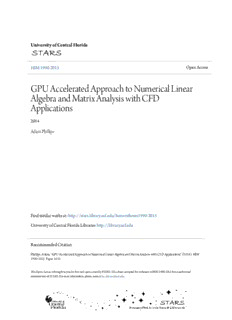Table Of ContentUUnniivveerrssiittyy ooff CCeennttrraall FFlloorriiddaa
SSTTAARRSS
HIM 1990-2015
2014
GGPPUU AAcccceelleerraatteedd AApppprrooaacchh ttoo NNuummeerriiccaall LLiinneeaarr AAllggeebbrraa aanndd
MMaattrriixx AAnnaallyyssiiss wwiitthh CCFFDD AApppplliiccaattiioonnss
Adam Phillips
University of Central Florida
Part of the Mathematics Commons
Find similar works at: https://stars.library.ucf.edu/honorstheses1990-2015
University of Central Florida Libraries http://library.ucf.edu
This Open Access is brought to you for free and open access by STARS. It has been accepted for inclusion in HIM
1990-2015 by an authorized administrator of STARS. For more information, please contact STARS@ucf.edu.
RReeccoommmmeennddeedd CCiittaattiioonn
Phillips, Adam, "GPU Accelerated Approach to Numerical Linear Algebra and Matrix Analysis with CFD
Applications" (2014). HIM 1990-2015. 1613.
https://stars.library.ucf.edu/honorstheses1990-2015/1613
GPUACCELERATEDAPPROACHTONUMERICALLINEARALGEBRA
ANDMATRIXANALYSISWITHCFDAPPLICATIONS
by
ADAMD.PHILLIPS
Athesissubmittedinpartialfulfilmentoftherequirements
fortheHonorsintheMajorPrograminMathematics
intheCollegeofSciences
andinTheBurnettHonorsCollege
attheUniversityofCentralFlorida
Orlando,Florida
SpringTerm2014
ThesisChair:Dr. BhimsenShivamoggi
(cid:13)c 2014AdamD.Phillips
AllRightsReserved
ii
ABSTRACT
A GPU accelerated approach to numerical linear algebra and matrix analysis with CFD applica-
tionsispresented. Theworksobjectivesareto(1)developstableandefficientalgorithmsutilizing
multiple NVIDIA GPUs with CUDA to accelerate common matrix computations, (2) optimize
these algorithms through CPU/GPU memory allocation, GPU kernel development, CPU/GPU
communication, data transfer and bandwidth control to (3) develop parallel CFD applications for
NavierStokesandLatticeBoltzmannanalysismethods. Specialconsiderationwillbegiventoper-
forming the linear algebra algorithms under certain matrix types (banded, dense, diagonal, sparse,
symmetric and triangular). Benchmarks are performed for all analyses with baseline CPU times
beingdeterminedtofindspeed-upfactorsandmeasurecomputationalcapabilityoftheGPUaccel-
erated algorithms. The GPU implemented algorithms used in this work along with the optimiza-
tiontechniquesperformedaremeasuredagainstpreexistingworkandtestmatricesavailableinthe
NISTMatrixMarket. CFDanalysislookedtostrengthentheassessmentofthisworkbyproviding
adirectengineeringapplicationtoanalysisthatwouldbenefitfrommatrixoptimizationtechniques
and accelerated algorithms. Overall, this work desired to develop optimization for selected linear
algebraandmatrixcomputationsperformedwithmodernGPUarchitecturesandCUDAdeveloper
whichwereapplieddirectlytomathematicalandengineeringapplicationsthroughCFDanalysis.
iii
DEDICATION
Thisthesiswouldn’thavebeenpossiblewithoutseveralkeyindividualsandsoftwares. Ihavebeen
blessed throughout my life with opportunities that have exposed me to new experiences, allowed
me to meet and interact with interesting and intelligent people, and directly impact others through
mytwopassions: teachingandresearch. Ilooktomentionafewnow.
Guidance provided by thesis advisor, Dr. Bhimsen Shivamoggi along with committee
members Dr. Zhisheng Shuai and Dr. Alain Kassab served as the backbone throughout my aca-
demic career at UCF. Their insight, willingness, and trustworthiness helped instill a confidence in
myresearchabilities,apassionforscientificdiscoveryandadesiretoteachacademically.
A special thanks goes out to fellow researcher and friend, Kevin Gleason. The challenges
in the process of writing an undergraduate thesis, presenting research at conferences, and publish-
ing academic work were made easier by having someone to experience it with. My best wishes
goes out to him and his masters thesis under Dr. Shawn Putnam. Dr. Shawn Putnam gave my
firstexposuremyundergraduateresearchatUCF,andIamgratefulforhiscareerandresearchad-
vice. To Alan, Harish, Josh and Mehrdad I wish you the best in your academic careers and future
endeavors.
IwouldliketothankPeterBradleyandDr. RobertAmaroattheNationalInstituteofStan-
dards and Technology for their assistance and guidance during my research internship with the
DepartmentofHomelandSecurity. Uponcompletingthisinternship,Ikindledapassionforscien-
tificdiscoveryandsawresearchasaviablecareeroption,bothdirectresultsoftheirmentorship.
I would like to thank my bosses at Lockheed Martin, Kenneth Flowers and Dr. Paul Zarda
alongwithotherLockheedMartinengineersandinternsforthechallengingprojectswhileallowing
me to keep my academics first. Similar thanks goes to my bosses at Mitsubishi Power Systems of
America, Michael Glover and Alex Martinez for taking a chance on me as a freshman to be a
capableengineeringintern.
iv
I would like to thank Dr. Miao Liu for the opportunity to be an undergraduate teaching
assistant. The freedom to create audio solutions for the homework, help grade and administer
exams and understand the procedural background of teaching at a university gave me appreci-
ated teaching experience. Similar thanks goes to Mrs. Kim Small for the opportunity to teach
freshman engineering students. My exposure gained through experiences and knowledge gained
through mentorships, blended perfectly with my passion to help and teach other students. These
experiencesvalidatedmychoicetocontinuegraduatestudiestopursueresearchandteaching.
To all my friends, colleagues and acquaintances I thank you dearly. I will not attempt to
list names, as there have been too many individuals who fall under this category who have been
helpfulatcertaintimesinmylife.
Mostimportantly,thiswouldhavepossiblewithoutmyfamily: Mom,Dad,Breanna,Noah,
Grandma and Grandpa. To my brother Noah, you are the inspiration to my life and will be who I
will always live through. To my grandpa, I did what has to be done. The lessons I have learned
fromeachofthemhas leadtothecreationofauniqueindividual whowillalwaysdowhatisright
atallcostandlivestohelpotherssucceed.
Thanks goes out to NVIDIA for providing its free parallel computing platform in CUDA
equipped with the CUDA Toolkit which included programming guides, user manuals, and API
reference. WithoutNVIDIACUDA,programmingGPUswouldhavebeenaconvolutedandstren-
uoustask. ThanksgoesouttoLATEX foritseleganttypesettingsystem,TeXMAKERforitseffec-
tive editor in writing this thesis in LATEXand MiKTeX for compiling this thesis. Without LATEX, I
wouldhavebeenenslavedtowritethisthesisinMicrosoftWord.
Thanks goes out to the Burnett Honors College for the Honors in the Major program that
allows undergraduates to work on thesis projects, and the Office of Undergraduate Research for
encouraging research. And to the University of Central Florida, I thank you for the best years of
mylife. Theaccomplishments,experiencesandimpactsmadeduringmytimeasanundergraduate
issomethingthatwillalwaysmakemeaKnight.
v
ACKNOWLEDGMENTS
ThisworkwaspartiallyfundedbytheUCFUndergraduateResearchGrantandtheBurnettHonors
CollegeHIMScholarship.
vi
NOMENCLATURE
Engineering Symbols
A Area
n (x ,t) BooleanParticleNumber
α i
C ({n }) CollisionOperator
α β
ρ Density
α DiscreteVelocity
β DiscreteVelocity
B ExtensiveProperty
feq EquilibriumFunction
f(x,v,t) FluidParticleDistributionFunction
(cid:15) FluidParameter
∇ Gradient
g Gravity
b IntensiveProperty
l Length
m Mass
n NormalVector
t Time
v ParticleVelocity
α
p Pressure
τ RelaxationTime
v Velocity
V VelocityTensor
µ Viscosity
vii
V Volume
ω Weight
Mathematical Symbols
(x,y) 2DCartesianCoordinate
(x,y,z) 3DCartesianCoordinate
+ AdditionOperator
j ColumnIndex
δ ChangeinQuantity(Small)
∆ ChangeinQuantity(Large)
··· Ellipses
q Exponent
∈ ContainedIn
∀ ForAll
=⇒ Implies
i,j Indices
∞ Infinity
(cid:82)
IntegralNotation
m¯ Minus
· MultiplicationOperator
O( ) OrderofMagnitude
∂ 1stOrderPartialDerivativeNotation
∂t
∂2 2ndOrderPartialDerivativeNotation
∂t2
p¯ Plus
± Plus-Minus
(cid:81)
ProductNotation
viii
d RegularDerivativeNotation
dt
a ≤ x ≤ b RangingIndexxfromatob
i RowIndex
A ScalarA
s Sign
c Significand
(cid:80)
SummationNotation
∃ ThereExists
(cid:126)
A VectorA
Matrix Symbols
|A| CardinalityofsetA
n ColumnDimensionofMatrix
M ConjugateMatrix
det(M) DeterminantofMatrix
∩ IntersectionofSets
M−1 InverseMatrix
M |M PartitionedMatrix
m RowDimensionofMatrix
A SetA
|M|= m×n SizeofMatrix
M StandardMatrix
⊂ Subset
MT TransposeofMatrix
∪ UnionofSets
ix
Description:exams and understand the procedural background of teaching at a .. CAD design, business computations, and structural analysis gorithms such as Autodesk AutoCAD, Microsoft Excel, and Siemens PLM NX subsequently discuss the numerical linear algebra and CFD results of this work through

